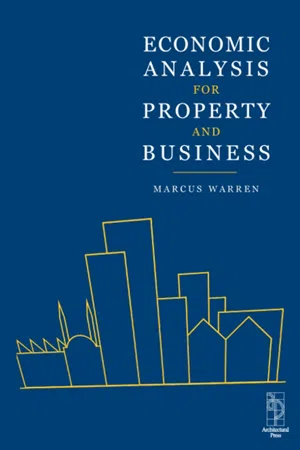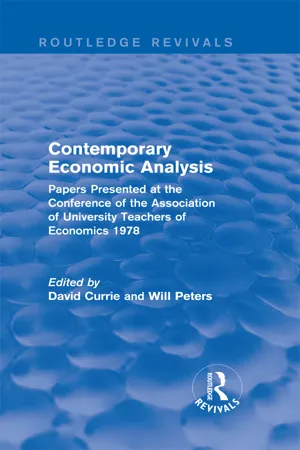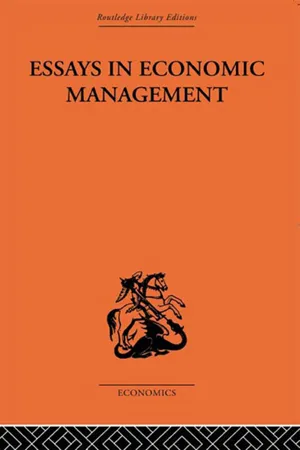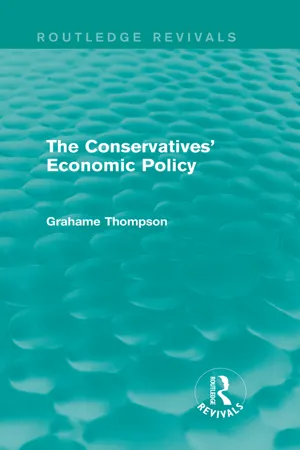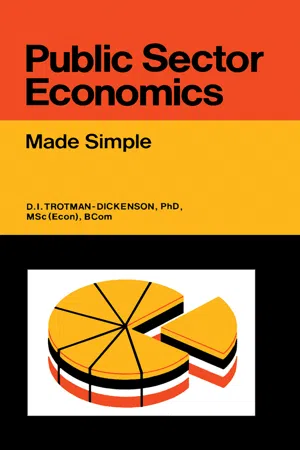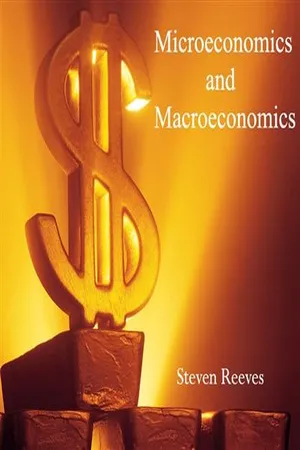Economics
Demand-side Policies
Demand-side policies refer to government actions aimed at influencing the level of aggregate demand in an economy. These policies typically involve measures to stimulate consumer spending and business investment, such as cutting taxes, increasing government spending, or lowering interest rates. The goal is to boost overall demand for goods and services, thereby stimulating economic growth and reducing unemployment.
Written by Perlego with AI-assistance
Related key terms
1 of 5
9 Key excerpts on "Demand-side Policies"
- eBook - ePub
- Marcus Warren(Author)
- 2007(Publication Date)
- Routledge(Publisher)
In reality though, it must be recognized that the impact and effectiveness of much economic policy is often severely reduced as some decisions are made for political reasons rather than purely economic ones. In fact it can be argued that many government actions are solely motivated for political gain. Such a political emphasis can eventually cause long-run damage to the economy in exchange for brief, vote catching, short-run economic successes.Demand management
Demand management is where the government tries to manipulate the level of aggregate demand in the economy. The two main policies that are available for such demand management are fiscal policy and monetary policy. These policies can be used independently, but it is more likely that they will be pursued in conjunction with one another in order to achieve overall economic objectives. The chosen emphasis upon either fiscal policy or monetary policy will depend upon the ideology of the government using the policy, as well as the task that demand management is being used for. The reasoning behind this statement should become apparent in the following analysis as fiscal policy and monetary policy are examined in detail. Reference to both Figures 10.1 and 12.1 will help an understanding of how these policies can be used. These two diagrams demonstrate how movements in the aggregate demand schedule follow through to the economic cycle.Fiscal policy
Fiscal policy is a demand management technique whereby governments directly intervene in the running of the economy. Fiscal measures involve changing either the level of government expenditure or the level of taxation. As this is a relatively direct approach to economic management, fiscal policy is seen as being a more interventionist policy than monetary policy. It is for this reason that a reliance on fiscal policy is often associated with governments that are to the left of the centre in political terms. However, it should be noted that most governments, whether on the ‘left’ or ‘right’ of the political spectrum will use a degree of fiscal policy in their management of the economy. Fiscal adjustments of government expenditure and taxation so as to fine-tune the economy are typically announced in annual budgets by the minister of finance, or equivalent (chancellor). - eBook - PDF
- Colin Harbury(Author)
- 2014(Publication Date)
- Pergamon(Publisher)
Fiscal policy can affect aggregate demand either directly by changing the levels of total government revenue and expenditure (budgeting for a surplus or deficit as required, or changing the Public Sector Borrowing Requirement, PSBR) or indirectly by altering the tax structure to stimulate private sector consumption or investment expenditure. Taxes can be either automatic stabilizers (which change automatically as income changes, e.g. progressive income taxes) or discretionary (which require positive acts by ministers to initiate them). Monetary policy affects aggregate demand by means of changes in the quantity of money and/or interest rates. Prices-incomes policies involve the setting of guide-lines for wage and price increases aimed principally at the control of inflation. No attempt can be made here to describe all the complexities of the debate, largely between Keynesians and Monetarists, on the advantages and disadvantages of different policy instruments. The background to the controversy is an imperfect understanding of the precise way in which the economy functions, the time lags involved, and the presence or absence of a faith in the efficiency of market forces themselves. Monetarists, sceptical of interventionist governments, tend to stress the difficulties involved with discretionary policies and to favour reliance on an automatic formula for increasing the money supply annually by an amount corresponding to the average growth of output. Keynesians tend to be sceptical of the efficiency of market forces in the short run and to advocate a policy mix of fiscal and monetary instruments (with perhaps a place for prices and incomes policies) to reduce cyclical fluctuations. The debate is thought by some to hinge, too, on whether the control of inflation or full employment and economic growth are the prime policy targets. - eBook - ePub
Contemporary Economic Analysis (Routledge Revivals)
Papers Presented at the Conference of the Association of University Teachers of Economics 1978
- David Currie, Will Peters(Authors)
- 2016(Publication Date)
- Routledge(Publisher)
At this time Keynesianism meant demand management policy to promote full employment, and demand management policy was effectively synonymous with macro-economic policy. 4 In fact, the annual budget was the centrepiece in the economic calendar. Conversion to demand management had occurred rapidly, its speed of acceptance being the result of the surprising unanimity of view amongst academics, the ‘obvious’ lessons of history, 5 its popularity with the electorate, as well as a deeper political appeal – it saved capitalism from the Marxists. Another factor at the technical level was that it had become possible to implement fiscal policy as a result of the greatly increased proportion of national income accounted for by taxation and public sector expenditure. Further, this extension was accepted by both political parties (excepting arguments about nationalisation). Thus demand management was possible and indeed welcomed. The claim to success of demand management is, however, both contentious and complicated to analyse. Five different possible criteria can be distinguished:- (1) the extent to which it reduced the average level of unemployment compared to periods before the Second World War; (2) its ability to regulate the trade cycle in specific years; (3) its effect on growth; (4) its effect on inflation; (5) its effect on the balance of payments. In fact in the 1950s some writers appeared to judge demand management capable of being successful on all five counts. For example, Crosland writing in 1956 said in a discussion of deflation and inflation: “Here, as always in this field, there is a golden mean” (Crosland, 1964, p. 197) and he expected only a mild inflation at full employment - eBook - ePub
- Alec Cairncross(Author)
- 2013(Publication Date)
- Routledge(Publisher)
6. Demand Management: Monetary Policy and Fiscal Policy 1The main purpose of monetary and fiscal policies, treated as the component parts of what is nowadays called demand management, is to regulate the pressure of demand. Ideally, if one could disregard the balance of payments and external factors, demand management would be designed to operate on the flow of income and expenditure so as to maintain full employment and let demand grow in step with the economic potential of the country. But things are in fact a great deal more complicated. Let me take in turn five of the main complications.First of all, the authorities can never entirely disregard the balance of payments and it is very often the prime object of their attention. To try to explain the development of monetary and fiscal weapons without bringing in the balance of payments would be a very curious proceeding, and I shall be returning to this point presently.Secondly, the objectives of demand management – particularly if they embrace the balance of payments – are not necessarily in harmony with one another. There are obvious conflicts between the claims of full employment, the balance of payments and price stability. If full employment is pushed too far the result is apt to be inflation, with the usual consequence of a deficit in the balance of payments and the draining away of liquid external reserves. If the balance of payments is given absolute priority, this may communicate to the economy at a time when it is under-employed strong deflationary pressures originating in other countries.Conflicting Policy ObjectivesSimilar conflicts arise, thirdly, with other objects of policy. Demand management is part of general economic policy and has to be harmonized with it. The range of economic policy and the objectives to which it is directed have become increasingly comprehensive and ambitious, covering full employment, faster growth, economic equality, a satisfactory balance of economic activity between regions and the encouragement of a satisfactory industrial structure. The effects of monetary and fiscal weapons on all of these objectives and not just on the pressure of demand have to be taken into account and may influence both the decision to use or refrain from using such weapons and the specific way in which monetary and fiscal policy is brought into play. These wider objectives of policy are themselves in conflict: too much concern for economic stability or regional balance, for example, may get in the way of economic growth. There are also conflicts all along the line between short-run and long-run considerations. One of the major problems of economic management is to resolve these conflicts and decide what weight to attach to each of the underlying objectives. But this is essentially a political, not a technical problem. It follows that demand management, however complex, is not something that can be left entirely to experts but has to be handled at the political level. So long as there is a choice between alternative policies with different outcomes for different groups in the community, different effects on particular outputs, individual regions, the level of capital investment, and so on, the choice is not one that can be made on technical grounds. - eBook - PDF
The Business Cycle
Growth and Crisis under Capitalism
- Howard J. Sherman(Author)
- 2014(Publication Date)
- Princeton University Press(Publisher)
economists and most U.S. politicians on a demand-oriented fiscal policy, usually considered to be "liberal" and "Keynesian." In its textbook description, it relied on two simple government policies to fine- 364 · Policy tune the economy, prevent inflation, and prevent cyclical contractions. In the first case, if there is unemployment (and no inflation), increase government spending, reduce government taxes, and allow the resulting deficit spending to stimulate demand. In the second case, if there is in- flation (and no unemployment), reduce government spending, increase taxes, and let the resulting surplus soak up excess demand. In the modern U.S. context, these policies are said to be liberal be- cause they would increase government activity in order to prevent the evils of unemployment and inflation. Policies are called conservative in the modern U.S. context if they would reduce government anticyclical activity, relying on the private capitalist system to automatically correct any problems. These policies were often called Keynesian, but Paul Samuelson re- named them the policies of the neoclassical-Keynesian synthesis because (1) they are Keynesian in the sense of requiring government activity to prevent unemployment and inflation, but (2) they are neoclassical in the sense that once full employment is restored, it is assumed that the pri- vate enterprise economy performs in an optimal way. The analysis was also neoclassical in the sense of positing that adjustment to full employ- ment was prevented only by wage-price rigidities or imperfections in the competitive process. Since these analyses and policies were far from what she considered to be Keynes's own view, Robinson (1979) called them "bastard Keynesian" analyses and policies. Whether or not this view was called a neoclassical-Keynesianism, it held strongly that fiscal policy could fine-tune the economy to eliminate the business cycle. - Grahame Thompson(Author)
- 2014(Publication Date)
- Routledge(Publisher)
The background to SSE stems from a reaction against Keynesianism with its emphasis on ‘demand management’. Keynesianism is demand sided, it is argued, and neglects or ignores the supply side of the economy. It stresses the manipulation of the components of aggregate demand to regulate the economy and assumes that whatever the level of such government stimulated demand, the supply to meet this will be forthcoming without producing serious economic problems. Supply-siders, however, challenge these assumptions. They argue that subsequent growth in the size of the government budget and extent of government intervention in the economy will produce inflationary pressure, but also a moribund and inflexible supply position. They are particularly concerned with the conditions of labour supply in this context, to which we return below. In general terms however the idea is to put strong downward pressure on the input costs of production, i.e. to increase the cost competitiveness of the economy.The struggle between these positions involves a number of doctrinal disputes which are not without their importance, and these are further discussed in the next section. But it is also important to recognise that this dissatisfaction with the emphasis on a Keynesian demand management macro-economic framework stems just as much, if not more, from the way it has ‘performed’ in the context of trying to manage the UK economy since 1945. One of the continually re-occurring problems has been that when demand was stimulated the expansion of the economy soon came up against supply-side bottlenecks and constraints. The failure of domestic supply to adapt quickly enough usually resulted in a sudden upsurge in imports to fill the supply gaps so created, and this engendered a subsequent balance of payments disequilibrium. The expansion then had to be halted to right the balance of payments position. This sluggishness of supply adjustment is a further reason for concern with it in a policy context.An interesting feature of SSE particularly in the American context is the way it has become predominantly associated with conditions in the labour market and with taxation and welfare benefits. Clearly a renewed focus on the supply-side of the economy could extend to a number of structural features involving the character and composition of the capital stock, its vintage and sectoral composition, the general state of technology, the organization of production, and on managerial and financial conditions etc., i.e. with the industrial structure overall and with the finance of investment, broadly conceived. By and large these areas have not formed a focus for SSE in the USA though they have been much more important in the UK. In Chapter 7- eBook - PDF
Public Sector Economics
Made Simple
- D. I. Trotman-Dickenson(Author)
- 2014(Publication Date)
- Made Simple(Publisher)
By the 1920s the possibility of unemployment could no longer be dismissed. It palpably existed, and by the 1930s it was an international phenomenon. Keynesian Prescription It is impossible to discuss fully in a few pages, such an important and difficult subject as the management of an economy and the Keynesian point of view. It will therefore be considered in broad outline. In 1936 Lord Keynes published his General Theory of Employment, In-terest and Money, which influenced fiscal policy for several generations to come and has its supporters to this day. Lord Keynes argued that aggregate demand need not equal supply and that by managing aggregate demand a Fiscal Policy to Stabilise an Economy 240 Public Sector Economies Management of Aggregate Demand Fiscal measures can be used to follow policies for: (i) expansion, if the aggregate demand is insufficient to absorb available resources so that there is unemployment, (ii) contraction, when demand is excessive and the price level rises. Expansionary policy. This is achieved by a government budget deficit, so that more money is pumped into the economy by means of public expendi-ture than is taken out in taxation. Budget measures are therefore likely to be as follows: A government will have to borrow to cover the deficit. Capital taxes are of little use in the management of aggregate demand because: (i) their total yield is small (see p. 185), (ii) the revenue generated is not regular, liability to a capital transfer tax arises only when a capital transfer is made, (iii) at a time of recession and falling prices capital gains on the disposal of assets are unlikely and therefore there will not be a tax base for a capital gains tax. A government will therefore rely on taxes on consumption and income. A reduction in direct taxation can be achieved by a cut in: (a) Income tax. A government may reduce tax rates, increase allowances, raise the level of tax thresholds, (b) Corporation tax. - eBook - ePub
- (Author)
- 2023(Publication Date)
- Wiley(Publisher)
By contrast, the decisions made by governments can have an enormous impact on even the largest and most developed of economies for two main reasons. First, the public sectors of most developed economies normally employ a significant proportion of the population, and they usually are responsible for a significant proportion of spending in an economy. Second, governments are also the largest borrowers in world debt markets. Exhibit 1 gives some idea of the scale of government borrowing and spending.Exhibit 1: Scale of Government Borrowing and SpendingPanel A. Central Government Debt to GDP, 2017Panel B. Public Sector Spending to GDP, 2017Source: IMF, World Economic Outlook Database, April 2018.Government policy is ultimately expressed through its borrowing and spending activities. In this reading, we identify and discuss two types of government policy that can affect the macroeconomy and financial markets: monetary policy and fiscal policy.Monetary policy refers to central bank activities that are directed toward influencing the quantity of money and credit in an economy. Central banks can implement monetary policy almost completely independent of government interference and influence at one end of the scale or may simply act as the agent of the government at the other end of the scale.By contrast, fiscal policy refers to the government’s decisions about taxation and spending. Both monetary and fiscal policies are used to regulate economic activity over time. They can be used to accelerate growth when an economy starts to slow or to moderate growth and activity when an economy starts to overheat. In addition, fiscal policy can be used to redistribute income and wealth.The overarching goal of both monetary and fiscal policy is normally the creation of an economic environment in which growth is stable and positive and inflation is stable and low. Crucially, the aim is to steer the underlying economy so that it does not experience economic booms that may be followed by extended periods of low or negative growth and high levels of unemployment. In such a stable economic environment, households can feel secure in their consumption and saving decisions, while corporations can concentrate on their investment decisions, on making their regular coupon payments to their bond holders, and on making profits for their shareholders. - No longer available |Learn more
- (Author)
- 2014(Publication Date)
- Orange Apple(Publisher)
____________________ WORLD TECHNOLOGIES ____________________ Chapter- 9 Fiscal Policy & Monetary Policy Fiscal Policy In economics, fiscal policy is the use of government expenditure and revenue collection to influence the economy. Fiscal policy can be contrasted with the other main type of macroeconomic policy, monetary policy, which attempts to stabilize the economy by controlling interest rates and the money supply. The two main instruments of fiscal policy are government expenditure and taxation. Changes in the level and composition of taxation and government spending can impact on the following variables in the economy: • Aggregate demand and the level of economic activity; • The pattern of resource allocation; • The distribution of income. Fiscal policy refers to the use of the government budget to influence the first of these: economic activity. Stances of fiscal policy The three possible stances of fiscal policy are neutral, expansionary and contractionary. The simplest definitions of these stances are as follows: • A neutral stance of fiscal policy implies a balanced economy. This results in a large tax revenue. Government spending is fully funded by tax revenue and overall the budget outcome has a neutral effect on the level of economic activity. • An expansionary stance of fiscal policy involves government spending exceeding tax revenue. • A contractionary fiscal policy occurs when government spending is lower than tax revenue. ____________________ WORLD TECHNOLOGIES ____________________ However, these definitions can be misleading because, even with no changes in spending or tax laws at all, cyclical fluctuations of the economy cause cyclical fluctuations of tax revenues and of some types of government spending, altering the deficit situation; these are not considered to be policy changes.
Index pages curate the most relevant extracts from our library of academic textbooks. They’ve been created using an in-house natural language model (NLM), each adding context and meaning to key research topics.
